This guest post and accompanying photographs are contributed by a guest writer, Alton Chiu. Alton currently writes for Small Arms Review. This is his second article contribution to TFB and is on the merits of using .22 LR ammunition for training.
22LR is well known for cheap plinking fun and for introducing junior shooters. Even with new adult shooters, the author had observed a desire to transition into “real” calibres as soon as possible from both the coach and trainee. This article explores how a 22LR rifle can be an effective training tool for seasoned and budding rifleman alike, because it is comparatively inexpensive and is less environmentally constrained.
Just like how a professional musician routinely practices scales and etudes to hone the basics, a seasoned rifleman should routinely practice the high power rifle discipline. Appleseed (RWVA) introduces many to the marksmanship basics, and the 22LR rifle is favoured for its cost effectiveness and minimal recoil. At 25m, any deviation can be attributed to the rifleman rather than equipment; this facilitates diagnostics by removing “golf excuses”. 22LR also allows volume practice at a reasonable cost. Factory match grade 5.56x45mm and 7.62x51mm cost about $1 per. While hand-loading can bring the 5.56x45mm cost to about $0.35 (excluding case), high quality 22LR such as SK and Eley is about $0.12 without the labour of reloading.
Wind reading is another critical marksmanship skill that should be habitually practiced. Ironically, the money and technology that allow a projectile to better buck the wind is undesirable for training because a long distance range is required to fully appreciate the wind effects. Geography does not always afford this luxury. In contrast, the 22LR shines as a windage training tool because its slow velocity and low ballistic coefficient allow it to approximate a centerfire cartridge at much closer distances. The following table show the range where the two cartridges have equal angular hold off in a 10mph wind.
22LR Subsonic 40gr 100m 150m 200m
6.5 Creedmoor 140gr 300m 420m 580m
This accessibility in range space and cost can help proliferate PRS-style 22LR club matches where positional skills are honed alongside fundamentals. The barrier to entry for the club is lower than a centerfire PRS match because the space needed is much smaller, and the steel targets are cheaper due to thinner gauge and smaller size. The barrier to entry for the rifleman is also lower due to reduced equipment and ammunition costs. The cost to try is nearly free because most already have a 22LR rifle and are also likely to have a spare “el-cheapo” scope. In addition, the inconsistencies of bulk 22LR ammunition would not impact enjoyment if the match is held inside 100m. Even a “no expense spared” 22LR rifle is notably cheaper than that of a centerfire precision rifle. The low barrier to entry helps to draw in new shooters, and eases the burden on the club.
22LR also proves an excellent training vehicle in the high volume action-shooting discipline where steel targets provide immediate feedback. Instead of using centerfire calibres that require expensive steel to withstand the impact and specially angled stands to manage splatter, one can substitute 22LR and practice on cheaper steel with reduced splatter. The cost effectiveness of 22LR further shines when the relaxed accuracy requirements allow the use of bulk ammunition. Cursory search showed bulk 22LR (e.g. Federal AutoMatch) to cost 5cents per and bulk 5.56x45mm (e.g. Wolf 55gr steel case) to cost 20cents per. Although 22LR cannot mimic centerfire recoil, the quadrupled volume helps the action-shooting discipline because skills such as the double-tap cannot be honed with dry fire.
The author assembled a 22LR AR upper as a companion to his 18” AR-15. The same Seekins 12” SP3R V3 handguard and matching upper were used to maintain consistent handling. The 22LR upper featured a Nightforce SHV 4-14×50 F1 which shared the same MIL-R reticle with the NXS 2.5-10×32 of the 5.56 upper. The reduced distances of 22LR necessitated the parallax adjustment of the SHV. A Bobro 20MOA QD scope mount was used so that the author may substitute an Aimpoint CompM4 to practice “run-n-gun”. The Beyer 16” barrel gave excellent accuracy, and a CMMG bolt rounded out the internals. The lower receiver and its Geissele National Match trigger were shared between calibres. The author opted for a Boonie Packer Better-Mag adaptor to retain bolt hold open function in the 22LR upper. A 10 round magazine was used for easier handling in unconventional shooting positions.
The author noticed that bulk 22LR ammunition produced good groups at 50m, with fliers appearing by 100m. When shooting to 130m, the author noticed that SK Standard Plus (40gr subsonic) had much more consistent performance than the CCI Mini Mag (40gr supersonic). The author believed this was partly due to the super- to sub- sonic transition and associated buffeting. It is noteworthy that the 5.0mil bullet drop of the subsonic is significantly more than the 3.7mil of the supersonic.
This article examined the cost efficiency and easy accessibility of 22LR as a serious marksmanship training tool, worthy of a home with seasoned and budding rifleman alike. If this piece had piqued the readers’ interests, the author encourages them to attend the next 22LR match at their local club, or even start a club match.
 Your Privacy Choices
Your Privacy Choices




